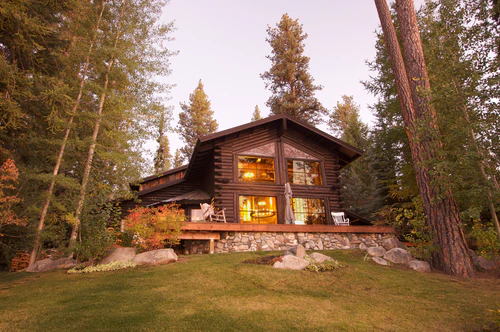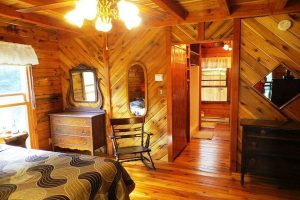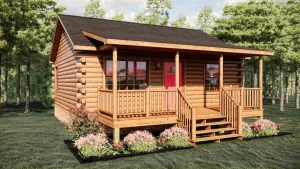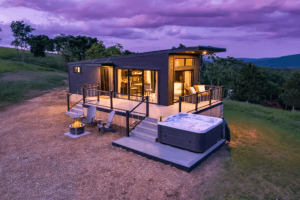Imagine stepping outside your log cabin, greeted by the vibrant colors of native flowers and the gentle rustling of leaves. Sustainable landscaping transforms not just the appearance of your property but also its relationship with nature. As more people seek to harmonize their living spaces with the environment, sustainable practices in landscaping have become essential.
This approach goes beyond aesthetics; it nurtures ecosystems, conserves resources, and fosters biodiversity. Whether you’re looking to create a serene retreat or enhance your outdoor space’s ecological value, sustainable landscaping offers countless benefits for log cabin properties nestled in nature’s embrace. Let’s explore how you can cultivate an enchanting landscape that respects both beauty and sustainability.
Benefits of sustainable landscaping for log cabin properties
Sustainable landscaping offers numerous advantages for log cabin properties. It enhances the natural beauty of the surroundings, blending seamlessly with the rustic charm of wood and stone.
By using eco-friendly practices, you can reduce maintenance costs over time. Native plants require less water and fertilizer, making your landscape more resilient to local climate conditions.
Wildlife thrives in sustainable environments. With thoughtful planning, your property can attract beneficial insects and birds while providing habitats that support biodiversity.
Additionally, these landscapes often improve air quality by filtering pollutants. They contribute to a healthier ecosystem overall.
A well-designed sustainable landscape increases property value too. Prospective buyers are drawn to eco-conscious features that promise lower upkeep expenses and environmental benefits. Embracing sustainability not only beautifies your log cabin but also aligns with modern values of conservation and responsible living.
Choosing native plants and wildflowers
Choosing native plants and wildflowers for your log cabin landscape is a smart move. These plants are adapted to the local climate, soil, and wildlife. They require less water and maintenance compared to non-native species.
Native plants also support local ecosystems. Birds, butterflies, and bees thrive on them. By planting this flora, you create a vibrant habitat that benefits the environment.
Consider seasonal blooms that add color throughout the year. Wildflowers like black-eyed Susans or coneflowers can create stunning displays while attracting pollinators.
Moreover, native plants contribute to soil health by reducing erosion. Their deep roots help retain moisture and nutrients in the ground.
Visit local nurseries or extension services for guidance on which varieties best suit your area. Embracing nature’s own palette not only enhances beauty but also fosters biodiversity right outside your doorstep.
Incorporating natural elements into your landscape design
Integrating natural elements into your landscape design creates harmony between your log cabin and the surrounding environment. Start by using locally sourced stones to build pathways or retaining walls. This not only blends with the landscape but also adds a rugged charm.
Consider incorporating logs, branches, or driftwood as decorative features. They can serve as rustic planters or seating areas, enhancing the natural aesthetic of your property.
Water features like ponds or streams attract wildlife and provide soothing sounds. A small fountain made from rocks can create a serene atmosphere while promoting biodiversity.
Think about creating elevation changes with hills and mounds using native soil. This adds depth to your landscape while encouraging drainage and preventing erosion. Each element should feel organic, inviting both you and nature to coexist peacefully in this beautiful setting.
Using rainwater harvesting and greywater systems
Harnessing rainwater can significantly enhance your log cabin’s sustainability. By capturing rainfall from rooftops and storing it in barrels or tanks, you reduce reliance on municipal water sources. This approach not only conserves water but also minimizes runoff that could lead to erosion.
Greywater systems offer another eco-friendly option by recycling water from baths, sinks, and washing machines. Instead of flowing straight into the sewer, this treated wastewater can nourish gardens or landscaping when managed properly.
Both methods lower utility bills while promoting responsible resource use. Implementing these systems creates a self-sustaining cycle that benefits both your property and the environment around it.
Always check local regulations before installation to ensure compliance with safety standards. Making these adjustments will enhance your landscape’s resilience against droughts and support healthier plant growth over time.
Composting and mulching for a healthy lawn and garden
Composting is a natural way to recycle kitchen scraps and yard waste. It enriches the soil, boosting its health over time. This process not only reduces landfill waste but also provides your plants with vital nutrients.
Creating a compost pile can be simple. Combine green materials like fruit peels with brown items like dried leaves. Turn it occasionally to aerate the mixture for optimal decomposition.
Mulching serves as an excellent companion to composting. Spread organic mulch around your garden beds, and watch how it suppresses weeds while retaining moisture in the soil.
Both practices promote healthy root systems and improve plant vitality significantly. Using these methods together can lead you toward a lush landscape that thrives naturally without harsh chemicals or excessive watering. Embrace nature’s cycles; they offer remarkable benefits for both you and your garden.
Creating wildlife habitats on your property
Creating wildlife habitats on your log cabin property can be a rewarding endeavor. Start by planting native trees and shrubs that provide food and shelter for local birds, butterflies, and small mammals.
Consider adding water features like birdbaths or ponds. These attract various species while also enhancing the beauty of your landscape.
Leave areas of tall grass or wildflowers untouched to serve as natural cover for various critters. This not only promotes biodiversity but also adds character to your yard.
Incorporate nesting boxes for birds or bee hotels to encourage pollinators. These structures offer safe spaces for wildlife, contributing positively to the ecosystem around you.
Avoid chemical pesticides and fertilizers. Instead, embrace organic gardening methods that protect both wildlife and soil health. Creating a vibrant habitat fosters connection with nature right outside your door.
Maintenance tips for sustainable landscaping
Regular maintenance is key to a thriving, sustainable landscape. Start by checking your plants frequently for signs of pests or diseases. Early detection can save you time and resources.
Mulching is essential. A good layer reduces weeds, keeps moisture in the soil, and adds organic matter as it breaks down. Choose natural mulches like bark or straw that align with your eco-friendly goals.
Mow less often and higher than usual. This encourages deeper root systems, which improves drought resistance while reducing stress on your lawn during hot months.
Rotate garden beds each season to promote healthier soil and prevent nutrient depletion. It’s an easy way to keep things vibrant without relying on chemical fertilizers.
Make sure to prune trees and shrubs regularly. This helps maintain their health while allowing sunlight and air circulation throughout the landscape. Healthy plants are more resilient against environmental challenges.
Budget-friendly options for sustainable landscaping
Sustainable landscaping doesn’t have to break the bank. There are plenty of budget-friendly options that can transform your log cabin property into an eco-friendly paradise.
Start by propagating plants from cuttings or seeds. This not only saves money but also allows you to customize your garden with native species. Many local nurseries offer free workshops on how to propagate, so take advantage.
Consider xeriscaping, which uses drought-resistant plants that require minimal water. It’s low maintenance and reduces utility costs over time.
Recycled materials can be a goldmine for unique features. Old pallets work wonderfully for vertical gardens, while stones found on-site make excellent pathways or borders.
Mulching is another affordable way to improve soil health and retain moisture in your garden beds. You can often find wood chips at no cost from local tree trimming services.
These approaches enable you to create beauty sustainably while keeping expenses down.
Conclusion: Enjoying a beautiful, eco-friendly landscape at
Transforming your log cabin property into a sustainable haven is rewarding. Each choice you make contributes to the health of your environment.
Imagine waking up every day to a vibrant landscape, filled with native plants and buzzing pollinators. This natural beauty enhances not just the aesthetic but also promotes ecological balance.
With proper planning and thoughtful design, your outdoor space can thrive without compromising resources. Every flower, tree, or shrub serves a purpose—supporting wildlife and enriching soil quality.
Embracing eco-friendly practices fosters a connection with nature that’s hard to beat. Your efforts create an inviting oasis for family and friends while leaving a positive impact on local ecosystems.
Enjoy every moment spent in this serene setting as it evolves over time, becoming more lush and diverse. Nature has its way of rewarding those who nurture it. A beautiful landscape awaits you!
References
Creating a sustainable landscape around your log cabin not only enhances its natural beauty but also contributes positively to the environment. By implementing eco-friendly practices, you can enjoy a vibrant outdoor space while supporting local wildlife and conserving resources. From choosing native plants to employing rainwater harvesting techniques, there are numerous ways to cultivate an inviting and sustainable oasis.
As you embark on this journey, remember that even small changes can make a significant impact. With careful planning and creativity, your log cabin property can become a model of ecological stewardship and aesthetic appeal.
If you’re looking for more information or need guidance in your sustainable landscaping efforts, the following references provide valuable insights:
1. “The Benefits of Native Plants”—US Fish & Wildlife Service
2. “Rainwater Harvesting: A Comprehensive Guide” – The Rainwater Harvesting Association
3. “Composting “Basics”—Environmental Protection Agency (EPA)
4. “Creating Wildlife Habitats in Your “Backyard”—National Wildlife Federation
5. “Sustainable Landscaping” – American Society of Landscape Architects
These resources will help deepen your understanding and inspire further ideas for making environmentally conscious choices in your landscaping endeavors.




